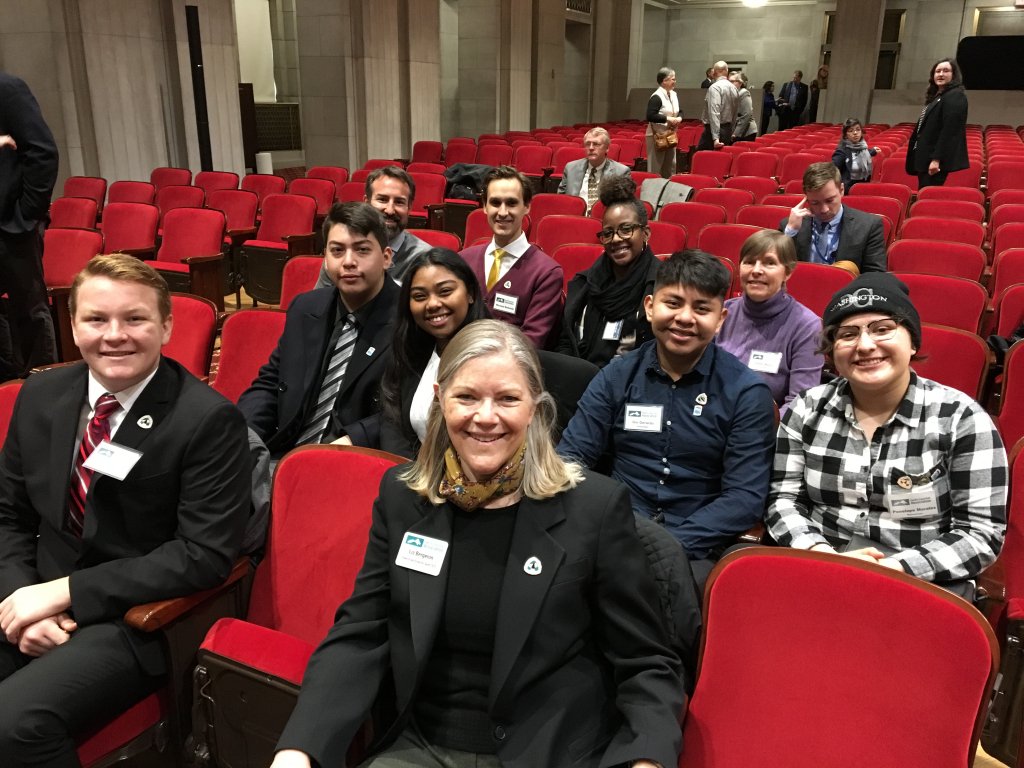Caption: PCTA executive director Liz Bergeron (center) and ECHS student advocates attend a Rivers and Trails 50th Anniversary event at the Department of Interior.
Originally posted on the Pacific Crest Trail Association Blog
By Mike Larabee
WASHINGTON, D.C. — Part of the PCTA’s work to protect and care for the Pacific Crest Trail happens far from the beauty and calm of your favorite backcountry campsite.
Every February, PCTA volunteers and staff make the long cross-country journey to Washington, D.C., where we meet with members of Congress and their staffs, our federal agency partners and folks from our sister trail groups and other nonprofit advocacy groups, such as the Back Country Horsemen of America.
The event is called “Hike the Hill” and it’s sponsored by the Partnership for the National Trails System and the American Hiking Society. We’re here to talk with members of Congress about the importance of robust funding to support our system of National Scenic and Historic Trails and the agencies that manage them, as well as bills Congress is considering that could influence trails, public lands and recreation.
Young PCT advocates impress lawmakers
Also joining us were four students and three teachers from the Environmental Charter High School in Lawndale, California. As part of their studies, these students join PCTA for weekend trail maintenance projects in Southern California. Through our partnership with the school, we have brought students to Hike the Hill for several years. The trip to D.C. offers these students a vision of our work that is surely different from what they see in the mountains, but one that is no less important to the long-term viability of trails and outdoor recreation in the U.S.
This week, they met with leaders of the U.S. Forest Service, consulted with young congressional staffers about career opportunities, toured the Capitol building and a local university, and visited several museums. On Wednesday, they joined our four teams of staff and volunteers as we fanned out across Capitol Hill for a full day of meetings with elected representatives and their staffs.

Caption: ECHS student Gio Gerardo and PCTA volunteer Bill Meyer speak with Shana Chandler from Washington Rep. Adam Smith’s office. Photo by Mark Larabee.
“It’s really important for us to be here,” said Liz Bergeron, executive director and CEO of the PCTA. “Building strong relationships between the PCTA and members of Congress and with our agency partners matters for the trail in the long run. We’ve seen results and the trail is better because of this work.”
This advocacy effort takes a lot of planning and coordination, but it makes a real difference. Throughout the week, we’ve visited with dozens of elected leaders and their staff members from California, Oregon and Washington. There is a lot of support for the Pacific Crest Trail among the Congressional delegation, and during our visits, our volunteers tell personal stories about their PCT experiences and why the trail matters to them. These encounters help members of Congress understand the positive impact the PCT has on peoples’ lives as they make decisions about the federal budget.
Highlighting your effort and dedication to Congress
When we talk about the budget with members of Congress, we remind them of the PCTA’s commitment—which is your commitment—to taking care of the trail. We share with them the fact that PCTA volunteers devoted 96,552 hours to the trail in 2017, an in-kind value of more than $2.3 million. And we tell them about the nearly $2.3 million you donated as well. Our association’s contribution to the trail for 2017 was just over $4.6 million. We get about a third of our operating budget from the federal government, and our agency partners and members of Congress are impressed by your effort and dedication.
The federal budget includes operational funds for agencies to manage the trail as well as Land and Water Conservation Fund dollars to purchase private properties that the trail passes through—or near—and have been identified as vital for preserving the PCT and the experience for users. The LWCF was created in 1965 and dedicates a percentage of lease payments on offshore oil and gas exploration for public land conservation projects. It is set to expire in September, and we continue to urge Congress to reauthorize and fully fund this program to help protect the last 10 percent of the trail that is on private property. Bills in the House of Representatives and the Senate already have a lot of bipartisan support.
We also met with our partners in the U.S. Forest Service, Bureau of Land Management and National Park Service to discuss other pressing issues involving the trail. We spoke about our goals for the PCT and a variety of issues and legislation that affects it. The ultimate goal of our visit here is to build awareness and support among people in government who can make a difference for this great public treasure that is our National Trails System.

Caption: PCTA volunteers Bill Meyer and Chris Sanderson, Oregon Rep. Greg Walden, and Mike Dawson, PCTA director of trail operations.
On Monday afternoon, the ECHS students were able to meet U.S. Forest Service Chief Tony Tooke and tell him about their trail experiences. Many representatives of national scenic and historic trail groups attended the gathering, and Chief Tooke praised the work we all do to care for our trails. He said a sustainable future for trails will not happen without the collaborative relationships the agencies have with volunteer groups.
“Our work with partners and volunteers has become woven into the fabric of the U.S. Forest Service,” he said.
Celebrating the National Trails System Act’s 50th Anniversary
Peppered throughout the week were events celebrating the 50th anniversary of the National Trails System Act and the Wild and Scenic Rivers Act. Both these landmark pieces of legislation were signed on Oct. 2, 1968 by President Lyndon Johnson. We reminded our elected representatives of the upcoming anniversary and urged them to look to the next 50 years of trails and rivers with strong support for the scenic, historic, recreational and conservation values embodied in these bold, forward-thinking laws.
A big thank you to our volunteers, who pay their own expenses to join us at this important event: Chris Sanderson, Bill Meyer, Bill Dahnke, Ken Schwarz, Rick Thalhammer, Phil Higelin and Barney and Sandy Mann. And a special thanks to our friends at the Environmental Charter High School, including 11th graders Kianna Kinsey, Penelope Morales, Seri Alvarez and Gio Gerardo—and their teachers Christian Rollino, Michael Badulak and Lacey Harris—for joining us as well.
We could not do this important work without them—or all of you.
View the original blog post here.







